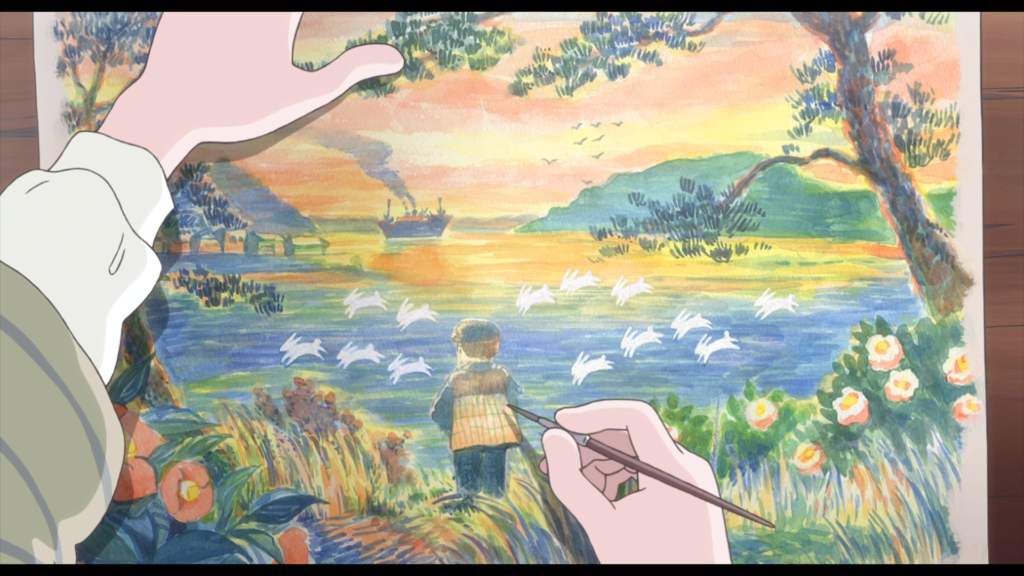
An innocent dreamer with a love of drawing, Suzu grows up in Hiroshima in the 1930s and early 1940s. At age eighteen, she receives a marriage proposal from a man she doesn’t know, and moves across the country to live with him. As she gets to know her new family and learns to run a household, Suzu must also deal with the realities of rationing and bombing during World War II.
I was initially meant to see In This Corner of the World at the 2018 Cheltenham Literature Festival, as part of a double bill with The Red Turtle. If you’ve read my review of that film, you’ll know that the venue for the screening was too uncomfortable to encourage me to stay. Instead, I eventually paid the requisite money to purchase the film on Amazon Video.
Ironically, earlier that very day, I’d been quietly amused that a friend wanted to watch Grave of the Fireflies, an admittedly very good but also famously depressing movie. And yet, here I was, watching a film set in and around Hiroshima in the 1940s, with full knowledge of what fate was in store for the denizens of that particular city.
Nonetheless, In This Corner of the World starts out innocently enough, as we follow Suzu on her journey from child to adult. The simplistic art style adds a dreamlike quality to the film, which is in some places charming, and in others makes it harder to distinguish reality from Suzu’s dreams and flights of fancy. It also makes it hard to get a feel for how Suzu is growing up – even as an adult she’s so small and childlike that I didn’t realise she had turned eighteen until it was stated in the dialogue.
The bulk of the movie takes place after Suzu’s arranged marriage, as we follow her to Kure to join her new husband and in-laws. The ditzy dreamer Suzu seems like the last person on Earth able to take on the role of homemaker, especially with the added challenges of a particularly demanding sister-in-law, and the increased hardships of food shortages, rationing, and the ever present threat of bombings. What we witness, however, is Suzu growing into her role, working hard for the community, and even coming up with delightfully ingenious ways to stretch out the family’s meagre food ration. We see her grow, mature and acquire new skills, but without ever losing the core of who she is – she’s still dreamy, a little ditzy, and with an unshakeable love for drawing.
Along the way, we also see Suzu and her husband Shusaku start to tentatively develop feelings for each other, leading to a powerful moment when her first love comes to visit. It’s clear that Suzu still likes him a lot, and when they are alone together she admits that she dreamt for so long that he would come and rescue her. In a rare display of anger, however, she has to admit it’s too late – her feelings for Shusaku have crept up on her, and how she doesn’t want to leave him. Given that so many movies push the message that there is only ‘true love’ in someone’s life, it’s actually refreshing to have a more pragmatic view of how things might work in real life. Sometimes you end up falling in love with the person who just happens to be there, rather than the person you thought you would end up with – especially in a society where arranged marriages are common.
As I touched on above, the setting of this movie does mean that there are darker elements present. The bombings of Japan are not just a backdrop to this movie – they have a real and present effect on Suzu and her family. The film does not shy away from depicting loss, and even though the overall message is a positive one about life continuing even in the face of adversity, this is not a film to choose if you need a cheerful pick-me-up.
It’s worth noting that, although the version of the film I watched clocks in at a respectable 129 minutes, last month an extended cut with thirty minutes of extra content was released in Japan. The extra time is apparently used to further develop Suzu’s relationships with both her husband Shusaku, and a girl named Lin who ends up working at a brothel. Whilst this latter relationship is somewhat brief in the original cut and could definitely use some fleshing out, two hours is already adequately long enough for pretty much any film. I’m mildly curious about the longer version, but I doubt I’ll ever get around to watching it.
Final Thoughts
Beneath its simplistic and dreamy animation style, In This Corner of The World offers a compelling look at life doing its best to continue amidst the trials and hardships of war. With a surprisingly broad emotional range, this film touches upon both the comical and the sad, making for a truly rounded and memorable experience.
Tier: Silver+
